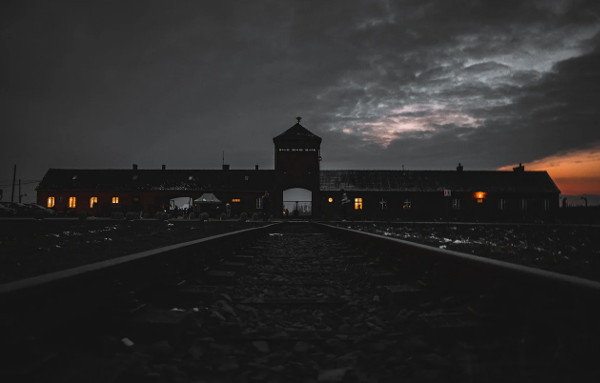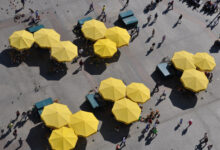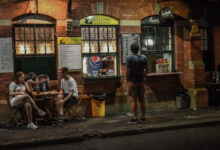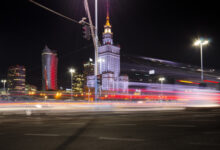As you plan your visit to Auschwitz, it is needed to be prepared and understand its historical significance. Auschwitz, a complex of Nazi concentration and extermination camps, was the site where approximately 1.1 million people lost their lives during the Second World War.
Spread over three main camps, Auschwitz I, Auschwitz II-Birkenau, and Auschwitz III-Monowitz, this dark chapter in history is now preserved as the Auschwitz-Birkenau Memorial and Museum.
Before embarking on your journey to Auschwitz, it’s important to know the practical aspects of visiting the site. Admission to the Auschwitz-Birkenau Memorial is free, but it’s recommended to reserve entry cards in advance.
To gain a deeper understanding of the history, you can opt for a guided tour with an educator, for which a fee is charged. Visiting hours vary depending on the time of year, with longer hours during the summer months.

The infamous Arbeit Macht Frei sign, located at the entrance to Auschwitz I, serves as a chilling reminder of the cruel reality faced by prisoners. This translates to “Work sets you free,” a slogan that falsely promised a hope for salvation through labour. Knowing the Auschwitz gate meaning and other historical context is essential for appreciating the magnitude of the atrocities that occurred there and for honouring the memory of the victims.
Table of Contents:
Planning Your Visit
Arranging Tour
There are a few options to choose from when visiting Auschwitz. You can join an all-inclusive guided tour, which is highly recommended, as it helps you avoid the hassle of transportation and ticket problems.
Alternatively, you can visit independently and join a guided tour once you arrive at the museum. Lastly, you can choose to explore the site on your own without a guide.
Auschwitz Admission and Fees
Admission to Auschwitz-Birkenau is free, but if you opt for a guided tour, fees will apply. The cost for a guided tour with an educator depends on the language: 80 PLN (in Polish) and 90 PLN (in other languages, including English).
Best Time to Visit Auschwitz
Auschwitz-Birkenau’s hours of operation are daily from 7:30 am until 7 pm during the months of June, July, and August.
There are reduced opening hours for the rest of the year. Be sure to book your Auschwitz Tour in advance as entry cards are required, especially during peak times.
Transportation to Auschwitz Birkenau Museum
Getting to Auschwitz is relatively simple from both Krakow and Warsaw. If you’re travelling from Krakow, direct trains run from the Main Railway Station to Oswiecim’s central station, which is just 2 km away from Auschwitz. The journey usually takes about 1.5 to 2.5 hours.
From Warsaw, you can either take a super-fast train to Krakow, which takes 2.5 hours, or a train from Warszawa Centralna that reaches Oswiecim via Katowice.
When arranging transportation, consider that depending on the tour you choose, some options may include transportation within the tour package, making it even easier for you to visit and explore the site.
What to Expect During Your Visit
Auschwitz I Guide
When visiting Auschwitz, you should be aware that the complex consists of two main sites: Auschwitz I and Birkenau (Auschwitz II).

At Auschwitz I, you can join a guided tour to better understand the history and events that unfolded at the camp. A guide will explain the significance of various buildings and exhibits within the camp, including the infamous gate bearing the message “Arbeit macht frei” (work sets you free).
Remember to reserve a guide at least two months in advance.
Birkenau Site
Birkenau, or Auschwitz II, is located about 3 kilometres from Auschwitz I and is the site where most of the mass extermination and forced labour occurred. It is a vast area that requires ample time for exploration, so be prepared for a lot of walking.
You can also join a guided tour of this site to gain a deeper understanding of the camp’s history and realities faced by the victims.
Memorial and Museum
During your visit, don’t miss the Auschwitz-Birkenau State Museum, which contains extensive exhibits and artefacts related to the Holocaust.
The museum provides a powerful and emotional experience that will leave a lasting impact on you. While admission to the Auschwitz-Birkenau Memorial is free, be sure to reserve entry cards on the official website beforehand.
Take note of the rules and appropriate behaviour during your visit, as this is a site of immense historical significance and serves as a memorial to the millions who suffered and perished. Dress respectfully and observe any rules concerning photography or restricted areas. Carry only small bags and wear comfortable shoes, as you will be walking for an extended period.
In summary, when visiting Auschwitz, be prepared to learn about and reflect on one of humanity’s darkest chapters through guided tours and visits to Auschwitz I, Birkenau, and the Memorial and Museum.
Rules and Regulations
Visitor Etiquette
When visiting Auschwitz, it is essential to maintain a respectful and sombre demeanour, as it is a site that holds the memory of thousands of people who lost their lives during the Holocaust. It is crucial to adhere to the rules for visiting this historically significant site, as you will be walking through the remnants of a concentration and extermination camp.
When exploring the museum, refrain from touching the exhibits and avoid any loud conversations or other disruptive behaviour. The Auschwitz Dress Code recommends wearing modest, comfortable clothing appropriate for the sombre atmosphere.
Bag Policies
Before entering the site, it is essential to keep in mind the bag policies in place. Large backpacks and handbags are not allowed on the premises, so it is necessary to leave them in your vehicle or the designated storage facilities.
Small bags that do not obstruct your movement are permitted, allowing you to carry essentials such as water, personal items, and a camera. Speaking of which, photography is allowed in most areas, but avoid taking pictures of places where it is explicitly prohibited. Following these guidelines will ensure a respectful and informative visit to Auschwitz.

Experiencing Auschwitz Today
Impacts on Tourism
Visiting Auschwitz can be an emotionally challenging experience, but it is important to remember and honour the lives lost at this extermination camp. As a visitor, you have several options for experiencing Auschwitz and Auschwitz II-Birkenau. You can reserve entry cards on visit.auschwitz.org for free admission to the grounds. For a deeper understanding of the history, a visit with a guide-educator is recommended. You can either join an all-inclusive guided tour, visit independently and join a tour at the museum, or visit independently without a guide.
As the number of visitors has increased, it is advised to reserve guides at least two months before your planned visit. It is possible to visit Auschwitz from Kraków by yourself, but joining a tour can be more convenient. Tours often include transportation and guidance, making your visit more streamlined. However, they can also be quite large and busy, potentially affecting the solemnity of the experience.
Preservation Efforts
The Memorial and Museum at Auschwitz-Birkenau was established to preserve the memory of the Holocaust and the lives of those who suffered at the hands of the Nazis.
The complex includes the remains of the gas chambers, where the mass extermination of Jews, political prisoners and other persecuted groups occurred. The “Arbeit Macht Frei” sign, railway tracks, and human hair on display serve as reminders of the horrors faced at Auschwitz.

When exploring the site, remember to be respectful and considerate, as it is a place of remembrance and reflection. Preservation efforts are in place to maintain the site; for example, the Arbeit Macht Frei sign was restored in 2009 after an act of vandalism.

As you visit Auschwitz, acknowledge the past horrors and pay tribute to the victims, while also remembering the importance of spreading messages of tolerance and understanding to prevent hate from once again consuming our world.









